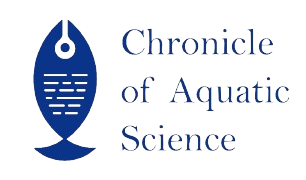| File | Action |
|---|---|
| CoAS_V1IS9_09 | Download |
- 919088951040 call us
- chronicleofaquaticscience@gmail.com Mail us
CoAS_V1IS9_09
Mini-review
Harmonizing Underwater: Exploring the Influence of Pheromones on Fish Communication and Behaviour
Narsingh Kashyap*1, Suresh Eswaran1, Jaiswar Rahul Ramasre1, Sanjay Chandravanshi2 and Chetna Kashyap3
Abstract
Fish communication and behavior are intricately linked to the influence of pheromones, chemical signals that play a vital role in social interactions among fish species. This review delves into the significance of pheromones in shaping fish behavior and communication patterns. Pheromones serve as powerful cues that facilitate various behaviors such as mating, territorial marking, and alarm responses. Understanding how fish perceive and respond to these chemical signals provides valuable insights into their social dynamics and ecological interactions. By exploring the intricate world of pheromones in fish communication, this research sheds light on the fascinating mechanisms that govern social behavior in aquatic environments.
Keywords
Phenomenon, Communication, Aquatic ecosystem, aquaculture
References
Falewee, C., Gaultier, E., Lafont, C., Bougrat, L., & Pageat, P. (2006). Effect of a synthetic equine maternal pheromone during a controlled fear-eliciting situation. Applied Animal Behaviour Science, 101(1-2), 144-153.
Kamio, M., & Derby, C. D. (2017). Finding food: how marine invertebrates use chemical cues to track and select food. Natural Product Reports, 34(5), 514-528.
Kobayashi, T., Kiyokawa, Y., Arata, S., Takeuchi, Y., & Mori, Y. (2013). c-Fos expression during the modulation of sexual behavior by an alarm pheromone. Behavioural brain research, 237, 230-237.
Li, W., Siefkes, M. J., Scott, A. P., & Teeter, J. H. (2003). Sex pheromone communication in the sea lamprey: implications for integrated management. Journal of Great Lakes Research, 29, 85-94.
Moore, A., & Waring, C. P. (1996). Electrophysiological and endocrinological evidence that F-series prostaglandins function as priming pheromones in mature male Atlantic salmon (Salmo salar) parr. Journal of Experimental Biology, 199(10), 2307-2316.
Murphy, C. A., & Stacey, N. E. (2002). Methyl-testosterone induces male-typical ventilatory behavior in response to putative steroidal pheromones in female round gobies (Neogobius melanostomus). Hormones and Behavior, 42(2), 109-115.
Murphy, C. A., Stacey, N. E., & Corkum, L. D. (2001). Putative steroidal pheromones in the round goby, Neogobius melanostomus: olfactory and behavioral responses. Journal of Chemical Ecology, 27, 443-470.
Ogata, H., Kitamura, S., & Takashima, F. (1994). Release of 13, 14-dihydro-15-keto-prostaglandin F2α, a sex pheromone, to water by cobitid loach following ovulatory stimulation. Fisheries science, 60(2), 143-148.
Sorensen, P. W., & Stacey, N. E. (2004). Brief review of fish pheromones and discussion of their possible uses in the control of non‐indigenous teleost fishes. New Zealand Journal of Marine and Freshwater Research, 38(3), 399-417.
Kamio, M., & Derby, C. D. (2017). Finding food: how marine invertebrates use chemical cues to track and select food. Natural Product Reports, 34(5), 514-528.
Kobayashi, T., Kiyokawa, Y., Arata, S., Takeuchi, Y., & Mori, Y. (2013). c-Fos expression during the modulation of sexual behavior by an alarm pheromone. Behavioural brain research, 237, 230-237.
Li, W., Siefkes, M. J., Scott, A. P., & Teeter, J. H. (2003). Sex pheromone communication in the sea lamprey: implications for integrated management. Journal of Great Lakes Research, 29, 85-94.
Moore, A., & Waring, C. P. (1996). Electrophysiological and endocrinological evidence that F-series prostaglandins function as priming pheromones in mature male Atlantic salmon (Salmo salar) parr. Journal of Experimental Biology, 199(10), 2307-2316.
Murphy, C. A., & Stacey, N. E. (2002). Methyl-testosterone induces male-typical ventilatory behavior in response to putative steroidal pheromones in female round gobies (Neogobius melanostomus). Hormones and Behavior, 42(2), 109-115.
Murphy, C. A., Stacey, N. E., & Corkum, L. D. (2001). Putative steroidal pheromones in the round goby, Neogobius melanostomus: olfactory and behavioral responses. Journal of Chemical Ecology, 27, 443-470.
Ogata, H., Kitamura, S., & Takashima, F. (1994). Release of 13, 14-dihydro-15-keto-prostaglandin F2α, a sex pheromone, to water by cobitid loach following ovulatory stimulation. Fisheries science, 60(2), 143-148.
Sorensen, P. W., & Stacey, N. E. (2004). Brief review of fish pheromones and discussion of their possible uses in the control of non‐indigenous teleost fishes. New Zealand Journal of Marine and Freshwater Research, 38(3), 399-417.
Sorensen, P. W., & Stacey, N. E. (2004). Brief review of fish pheromones and discussion of their possible uses in the control of non‐indigenous teleost fishes. New Zealand Journal of Marine and Freshwater Research, 38(3), 399-417. Stacey, N. (2011). Hormonally derived sex pheromones in fishes. In Hormones and reproduction of vertebrates (pp. 169-192). Academic Press.
Ueda, H., Yamamoto, Y., & Hino, H. (2007). Physiological mechanisms of homing ability in sockeye salmon: from behavior to molecules using a lacustrine model. In American Fisheries Society Symposium (Vol. 54, pp. 5-16). American Fisheries Society.
Unfer, G., & Pinter, K. (2017). Fisheries management of stream‐resident brown trout populations–possibilities and restrictions. Brown trout: Biology, ecology and management, 649-665.
Ueda, H., Yamamoto, Y., & Hino, H. (2007). Physiological mechanisms of homing ability in sockeye salmon: from behavior to molecules using a lacustrine model. In American Fisheries Society Symposium (Vol. 54, pp. 5-16). American Fisheries Society.
Unfer, G., & Pinter, K. (2017). Fisheries management of stream‐resident brown trout populations–possibilities and restrictions. Brown trout: Biology, ecology and management, 649-665.
- Published online
- 29th February, 2024
How to Cite the Article
Kashyap, N., Eswaran, S., Ramasre, J.R., Chandravanshi, S. and Kashyap, C. 2024. Harmonizing Underwater: Exploring the Influence of Pheromones on Fish Communication and Behaviour. Chronicle of Aquatic Science 1(9): 67-72
Copyright
This is an open-access article distributed under the terms of the Creative Commons Attribution License (CC BY). The use, distribution or reproduction in other forums is permitted, provided the original author(s) and the copyright owner(s) are credited and that the original publication in this journal is cited, in accordance with accepted academic practice. No use, distribution or reproduction is permitted which does not comply with these terms.

CoAS_V1IS9_09


